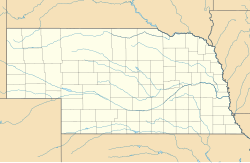Top Qs
Timeline
Chat
Perspective
University of Nebraska system
Public university system of Nebraska From Wikipedia, the free encyclopedia
Remove ads
The University of Nebraska system is the public university system of the U.S. state of Nebraska. The system was formed in 1968 from the merger of the University of Nebraska and the University of Omaha. The system has since expanded to include the University of Nebraska at Kearney, Nebraska College of Technical Agriculture, University of Nebraska Medical Center, and an online high school. Its flagship campus is the University of Nebraska–Lincoln.
Remove ads
History
The University of Nebraska system was formed in 1968 from the merger of the University of Nebraska and the University of Omaha.[5] Upon the merger's completion, the system originally included the University of Nebraska–Lincoln, the University of Nebraska at Omaha, and the University of Nebraska Medical Center, which the University of Nebraska–Lincoln had previously acquired in 1902.[6] The system later added the University of Nebraska at Kearney in 1990, and the Nebraska College of Technical Agriculture in 1994.[7][8]
Remove ads
Schools
Remove ads
Nebraska Institutes
The University of Nebraska has four interdisciplinary, University-wide institutes operating across the University of Nebraska system.
- Buffett Early Childhood Institute - Samuel J. Meisels, founding executive director
- National Strategic Research Institute - Robert Hinson, USAF Lt. General (ret.), founding executive director
- Robert B. Daugherty Water for Food Global Institute - Peter G. McCornick, executive director
- Rural Futures Institute - Chuck Schroeder, founding executive director
Two of NU's campuses also partner in the Peter Kiewit Institute, a facility in Omaha, Nebraska that houses academic programs from both the University of Nebraska-Lincoln's College of Engineering and the University of Nebraska at Omaha's College of Information Science and Technology.
NU Online Education
Online Worldwide is the virtual connection point to more than 100 online degrees, certificates, endorsements, and minors offered by the four campuses of the University of Nebraska system.[11] University of Nebraska High School is an accredited, university-based online high school. The online college preparatory curriculum allows students to earn high school credit or a diploma from anywhere around the world.[12]
Remove ads
Governance
Summarize
Perspective
Board of Regents
The University of Nebraska system is governed by the board of regents, a twelve-member panel consisting of eight voting members and a non-voting student body president from each campus. Voting members are elected by district to six-year terms; elections are held in even-numbered years. The board of regents meets at Varner Hall on East Campus and supervises the operation, expenditures, and tuition rates of each university in the system.
The Board of Regents was established as a constitutional office in the 1875 Nebraska State Constitution.[13] At the time, the regents were elected in partisan statewide elections to six-year terms.[14] In 1917, the legislature made the regental elections nonpartisan, and in 1920, voters ratified a constitutional amendment that provided for the election of the regents by district. The regents were elected from the state's congressional districts from 1923 to 1949, and from the Nebraska Supreme Court districts from 1949 to 1971. Beginning in 1971, the regents were elected in separate districts drawn by the state legislature, which are redrawn after each census.[15] In 1974, voters approved a constitutional amendment that added student members to the board of regents as nonvoting members.[14]
President
The president of the University of Nebraska system is appointed by and reports to the board of regents. The position was created in 1968 when the Municipal University of Omaha and the University of Nebraska Medical Center were absorbed into the University of Nebraska to create a state-wide system. Clifford M. Hardin was the first president and Ronald Roskens was the longest-tenured. Jeffrey P. Gold has been serving as Nebraska's president since July 1, 2024.[17]
Remove ads
See also
- Nebraska State College System, the other state institution of higher education
References
External links
Wikiwand - on
Seamless Wikipedia browsing. On steroids.
Remove ads



